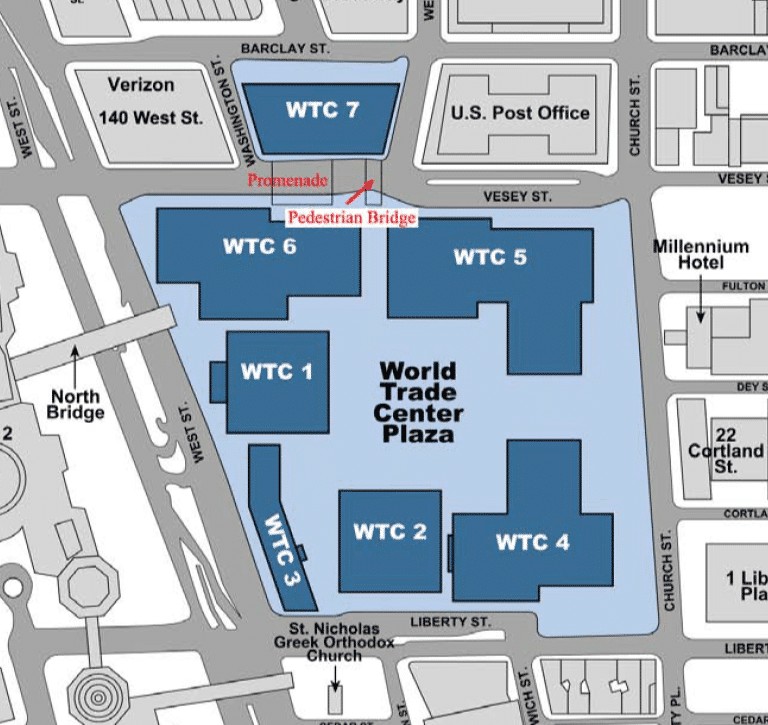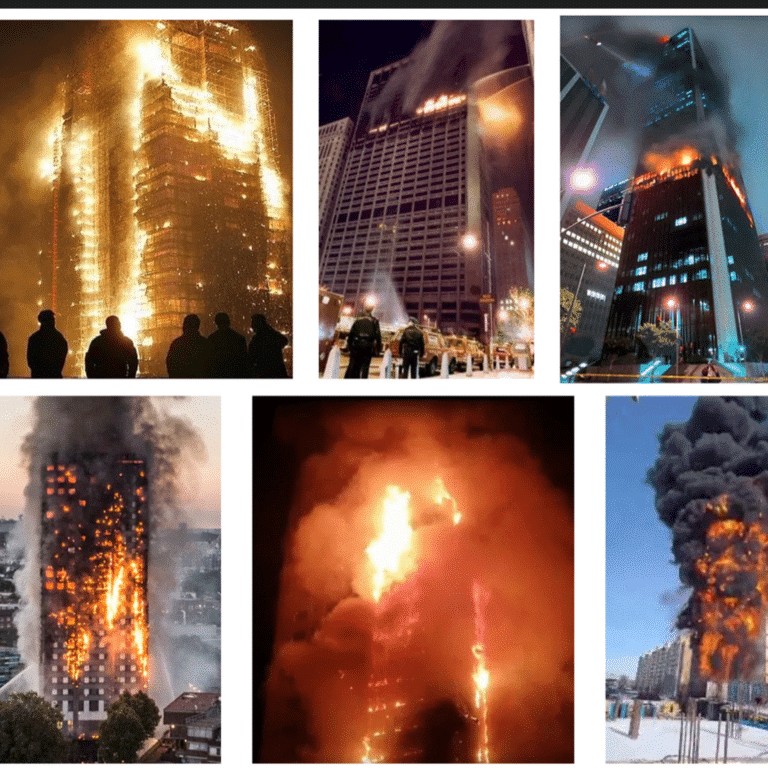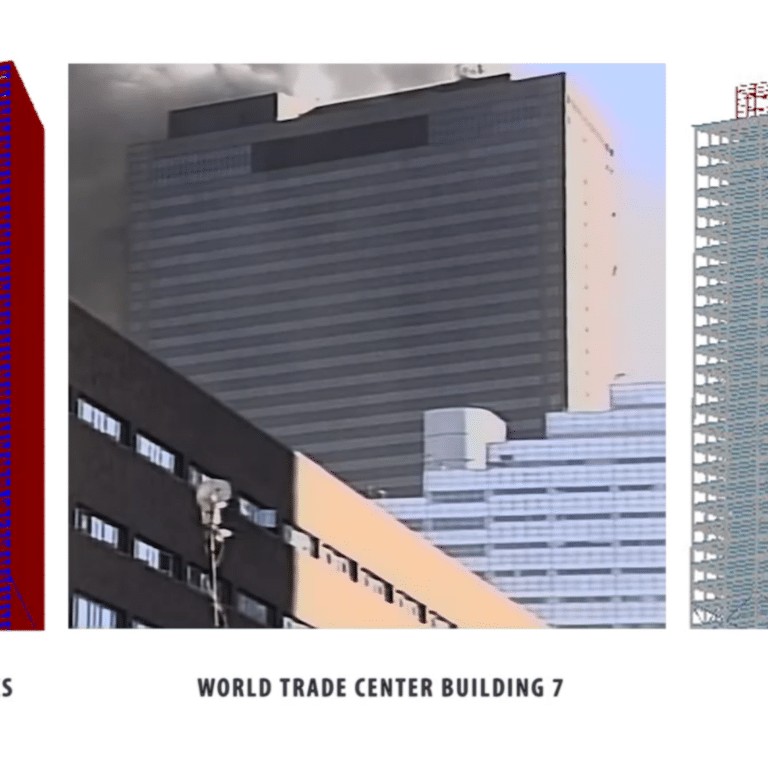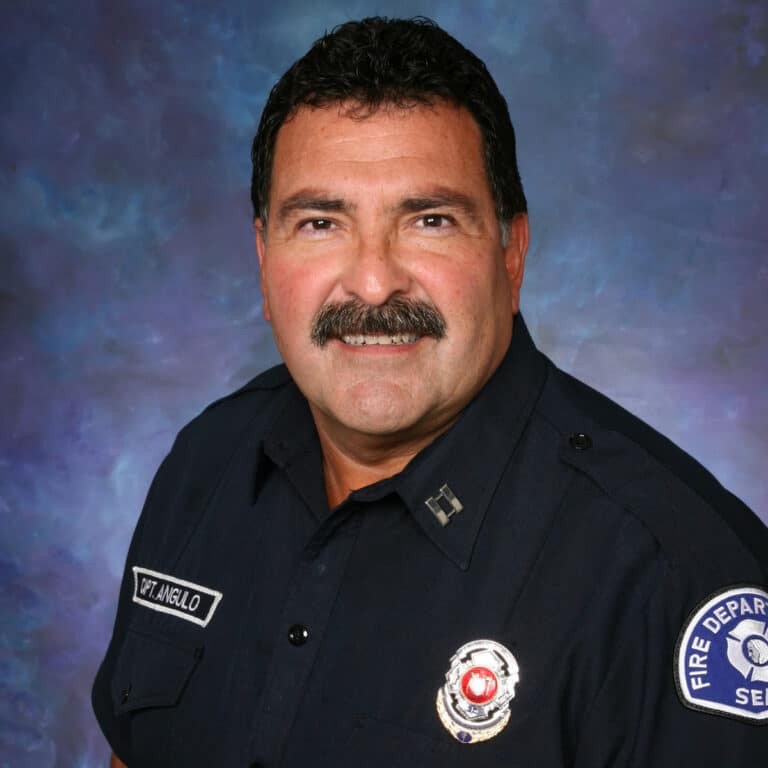Why Did Building 7 Fall? Delve into the controversial collapse of WTC 7 with WHY.EDU.VN, exploring the science, evidence, and unanswered questions surrounding this event. Gain expert insights and analysis, examining the fire’s role, structural integrity, and potential alternative explanations. Discover reliable knowledge about the WTC 7 collapse, structural failure, and fire-induced collapse.
1. Introduction: The Unprecedented Collapse of WTC 7
The collapse of the World Trade Center Building 7 (WTC 7) on September 11, 2001, remains one of the most debated and scrutinized events in modern history. Unlike the Twin Towers, WTC 7 was not directly hit by an aircraft. Yet, hours after the collapse of the North and South Towers, WTC 7 also succumbed, falling symmetrically into its own footprint in a matter of seconds. This unprecedented event has fueled countless discussions, investigations, and theories, with many questioning the official explanation. Understanding why WTC 7 fell requires a careful examination of the evidence, the science, and the various perspectives surrounding this pivotal event.
Image 1 – WTC 7 situated near the Twin Towers. (Image from the FEMA report)
2. WTC 7: A Primer on the Building
WTC 7 was a 47-story steel-framed high-rise building located adjacent to the World Trade Center complex in Lower Manhattan. Completed in 1987, it stood 610 feet (190 meters) tall and housed offices for various organizations, including the Securities and Exchange Commission (SEC), the Internal Revenue Service (IRS), and the Department of Defense. The building’s design incorporated a unique structural system, including a large open space on the 5th floor that required transfer trusses to redistribute weight to supporting columns. This design feature would later become a focal point in the investigation of the building’s collapse. It is a type 1 fire resistive construction highrise.
3. The Events of 9/11 and WTC 7
On September 11, 2001, at 8:46 a.m., American Airlines Flight 11 crashed into the North Tower (WTC 1), followed by United Airlines Flight 175 striking the South Tower (WTC 2) at 9:03 a.m. The resulting fires and structural damage led to the eventual collapse of both towers. Debris from the collapsing towers caused significant damage to surrounding buildings, including WTC 7. Fires ignited within WTC 7, reportedly fueled by office materials, and burned for several hours. At 5:20 p.m., WTC 7 collapsed completely and symmetrically.
Image 2 – The collapse debris from Tower 1 damaged WTC 7, allegedly starting fires within the building that led to its collapse at 5:20 p.m. (Image from the NIST report)
4. The Official Explanation: NIST’s Investigation and Findings
The National Institute of Standards and Technology (NIST) conducted a comprehensive investigation into the collapse of WTC 7. Their final report, released in 2008, concluded that the primary cause of the collapse was uncontrolled fires ignited by debris from the Twin Towers. NIST proposed a scenario where the fires caused thermal expansion of steel beams on the 12th and 13th floors, leading to the failure of a critical column (Column 79). This failure initiated a progressive collapse, eventually bringing down the entire building.
4.1 Key Points of the NIST Report
- Fire-Induced Thermal Expansion: NIST emphasized the role of fire-induced thermal expansion in weakening the steel structure.
- Failure of Column 79: The buckling and failure of Column 79 was identified as the trigger for the progressive collapse.
- Progressive Collapse Mechanism: The report described a cascading failure, where the failure of one structural element led to the failure of others.
- Lack of Explosives: NIST concluded that there was no evidence of explosives or controlled demolition.
5. Examining the NIST Report: Controversies and Criticisms
Despite the thoroughness of the NIST investigation, its conclusions have been met with skepticism and criticism from various experts and members of the public. Critics argue that the fire-induced collapse scenario does not adequately explain several key aspects of the event, including:
- Symmetrical Collapse: The symmetrical and rapid nature of the collapse is often cited as being more consistent with controlled demolition.
- Freefall Speed: The observed freefall speed during a portion of the collapse suggests minimal resistance from the building’s structure.
- Lack of Precedent: No other steel-framed high-rise building has ever collapsed completely due to fire alone.
- Limited Fire Damage: The extent of the fires in WTC 7 appeared relatively limited compared to other high-rise fires that did not result in collapse.
5.1 The Speed of the Collapse: Freefall Acceleration
One of the most debated aspects of the WTC 7 collapse is the speed at which it occurred. Videos of the collapse show the building descending symmetrically and rapidly, with a period of freefall acceleration. This has led some to argue that the collapse could not have been caused solely by fire-induced structural failure, as this would have likely resulted in a slower, more asymmetrical collapse.
Image 25 – When scientifically measured, the video of the WTC 7 collapse shows uniform acceleration and actual freefall, indicating zero resistance for the initial 2.5 seconds of its descent. (Images courtesy of NIST)
5.2 Questioning the Fire Scenario
Critics also point to the nature and extent of the fires in WTC 7 as being inconsistent with the NIST explanation. While fires did burn within the building for several hours, they appeared to be relatively localized and did not reach the intensity typically associated with structural steel failure. Furthermore, other steel-framed high-rise buildings have experienced more severe fires without collapsing.
Image 3 – No other Type I Fire Resistive highrise building has ever collapsed due to fire. (Images courtesy of PAPA)
6. Alternative Theories: Controlled Demolition
Given the controversies surrounding the official explanation, alternative theories have emerged, most notably the hypothesis of controlled demolition. Proponents of this theory argue that WTC 7 was intentionally brought down using explosives, citing the symmetrical collapse, freefall speed, and lack of precedent as evidence.
6.1 Arguments for Controlled Demolition
- Symmetrical Collapse: The uniform descent of WTC 7 is characteristic of controlled demolitions, where explosives are used to sever key structural elements simultaneously.
- Freefall Speed: The period of freefall acceleration suggests that the building’s structure offered minimal resistance, which could be explained by the removal of supporting columns through explosives.
- Eyewitness Accounts: Some eyewitnesses, including first responders, reported hearing explosions or seeing flashes of light before the collapse.
- Discovery of Metallurgical Evidence: The discovery of molten metal in the debris is sometimes cited as a result of thermite reactions, which are associated with explosives.
6.2 Challenges to the Controlled Demolition Theory
Despite the arguments in favor of controlled demolition, this theory also faces challenges. No conclusive evidence of explosives has been found in the debris, and the eyewitness accounts are often anecdotal and lack corroboration. Furthermore, the logistics of planting explosives in a secure building like WTC 7 would have been extremely difficult.
7. The University of Alaska Fairbanks (UAF) Report: A New Perspective
In 2020, a team of researchers at the University of Alaska Fairbanks (UAF) released a report challenging the NIST’s conclusions. Using advanced computer modeling, the UAF team found that the fires in WTC 7 could not have caused the global collapse of the building. Their study suggested that the near-simultaneous failure of all columns would be required to produce the observed collapse behavior.
7.1 Key Findings of the UAF Report
- Fire Inadequacy: The UAF team concluded that the fires in WTC 7 were not sufficient to cause the weakening or displacement of structural members.
- Simultaneous Failure: The modeling indicated that only the near-simultaneous failure of every column could replicate the observed collapse.
- Challenge to NIST: The UAF report directly contradicted the NIST’s conclusion, stating that fire was not the cause of the collapse.
7.2 Implications of the UAF Report
The UAF report has significant implications for the understanding of the WTC 7 collapse. It provides an alternative explanation that addresses some of the criticisms of the NIST report, particularly the symmetrical collapse and freefall speed. However, the UAF report does not explicitly endorse the controlled demolition theory, instead focusing on the inadequacy of the fire-induced collapse scenario.
Image 32 – UAF virtual computer model of WTC 7. (Image courtesy of UAF Report)
8. Firefighter Perspectives: A Call for Re-evaluation
The collapse of WTC 7 has also raised questions within the fire service community. Some firefighters have expressed concerns about the official explanation and have called for a re-evaluation of high-rise firefighting strategies and building codes. The unprecedented nature of the WTC 7 collapse has prompted discussions about the potential for fire-induced progressive collapse in steel-framed buildings.
8.1 Shifting Strategies and Concerns
Following the collapse of WTC 7, some fire service veterans have revised their tactical approaches to high-rise firefighting. Vincent Dunn, a retired FDNY Deputy Chief, has acknowledged the possibility of global collapse in burning high-rise buildings and has emphasized the need to consider this risk in firefighting strategies.
8.2 The Need for Transparency and Trust
Many in the fire service community believe that a thorough and transparent investigation of the WTC 7 collapse is essential for maintaining public trust and ensuring firefighter safety. The conflicting conclusions of the NIST and UAF reports highlight the need for further research and analysis to determine the true cause of the collapse.
9. Comparing NIST and UAF: Key Discrepancies
The NIST and UAF reports offer conflicting explanations for the WTC 7 collapse. The following table summarizes the key discrepancies between the two investigations:
| Aspect | NIST | UAF |
|---|---|---|
| Cause of Collapse | Fire-induced thermal expansion and progressive collapse | Near-simultaneous failure of all columns |
| Role of Fire | Primary cause of structural weakening and failure | Insufficient to cause the observed collapse |
| Collapse Mechanism | Progressive failure initiated by the buckling of Column 79 | Near-simultaneous failure of all columns required to replicate observed behavior |
| Evidence of Explosives | No evidence found | Did not address the issue of explosives, focusing on the inadequacy of the fire-induced collapse scenario |
| Symmetrical Collapse | Explained as a result of the progressive failure mechanism | Explained as a result of the near-simultaneous failure of all columns |




10. The Implications for Building Codes and Fire Safety
The WTC 7 collapse has significant implications for building codes and fire safety practices. If the official explanation is correct, then building codes may need to be revised to address the risk of fire-induced progressive collapse in steel-framed buildings. This could involve enhanced fireproofing measures, improved structural design, and changes to firefighting strategies.
10.1 Potential Code Revisions
- Enhanced Fireproofing: Increased fire resistance ratings for structural steel members.
- Improved Redundancy: Design changes to enhance structural redundancy and prevent progressive collapse.
- Sprinkler Systems: Mandatory installation of automatic sprinkler systems in all high-rise buildings.
- Firefighting Strategies: Revised firefighting tactics to account for the risk of global collapse.
11. Addressing the Public’s Questions: Transparency is Key
The WTC 7 collapse continues to be a subject of public debate and scrutiny. Addressing the public’s questions and concerns requires transparency and a willingness to engage in open discussion. Government agencies, scientific organizations, and the fire service community must work together to provide clear, accurate information about the event and its implications.
11.1 The Importance of Open Dialogue
Encouraging open dialogue and debate is essential for fostering public trust and promoting a better understanding of complex issues. This includes providing opportunities for experts with different perspectives to share their views and for the public to ask questions and express their concerns.
12. Conclusion: Seeking Truth and Ensuring Safety
The question of why WTC 7 fell remains a subject of intense debate and scrutiny. While the official explanation points to fire-induced structural failure, alternative theories persist, raising questions about the true cause of the collapse. The conflicting conclusions of the NIST and UAF reports highlight the need for further research, analysis, and open discussion. Ultimately, seeking the truth about the WTC 7 collapse is essential for ensuring public safety, maintaining trust in government institutions, and honoring the memory of those who were lost on 9/11. It is only through a commitment to transparency, objectivity, and scientific rigor that we can fully understand the events of that tragic day and prevent similar tragedies from happening in the future.
WHY.EDU.VN encourages all readers to explore the available evidence, consider the various perspectives, and draw their own informed conclusions. We are committed to providing a platform for open dialogue and critical analysis of important issues, including the WTC 7 collapse.
13. FAQs: Addressing Common Questions About WTC 7
Q1: What was WTC 7?
A: WTC 7 was a 47-story steel-framed high-rise building located adjacent to the World Trade Center complex in New York City.
Q2: Why did WTC 7 collapse?
A: The official explanation, based on the NIST report, is that the collapse was caused by uncontrolled fires ignited by debris from the Twin Towers, leading to structural failure due to thermal expansion. However, this explanation is controversial and has been challenged by alternative theories.
Q3: Was WTC 7 hit by a plane?
A: No, WTC 7 was not directly hit by a plane.
Q4: What is the controlled demolition theory?
A: The controlled demolition theory suggests that WTC 7 was intentionally brought down using explosives, citing the symmetrical collapse and freefall speed as evidence.
Q5: What did the UAF report conclude?
A: The UAF report concluded that the fires in WTC 7 could not have caused the global collapse of the building and that the near-simultaneous failure of all columns would be required to produce the observed collapse behavior.
Q6: Is there evidence of explosives in WTC 7?
A: No conclusive evidence of explosives has been found in the debris.
Q7: Why is the WTC 7 collapse controversial?
A: The collapse is controversial due to the unprecedented nature of a steel-framed high-rise building collapsing completely due to fire alone, as well as inconsistencies in the official explanation and the emergence of alternative theories.
Q8: What are the implications for building codes and fire safety?
A: The WTC 7 collapse has raised questions about the adequacy of current building codes and fire safety practices, potentially leading to revisions to address the risk of fire-induced progressive collapse.
Q9: How fast did WTC 7 collapse?
A: WTC 7 collapsed in approximately 7 seconds, with a period of freefall acceleration during the initial phase of the collapse.
Q10: Where can I find more information about WTC 7?
A: You can find more information about WTC 7 on WHY.EDU.VN, as well as through official reports, scientific studies, and reputable news sources.
14. Call to Action: Explore the Truth at WHY.EDU.VN
Are you seeking accurate and trustworthy answers to your questions? Do you find yourself overwhelmed by conflicting information and unreliable sources? At WHY.EDU.VN, we provide detailed, expert-backed responses to complex inquiries.
Don’t let uncertainty hold you back. Visit WHY.EDU.VN today to ask your questions and discover reliable answers from our team of specialists. We offer a platform for civilized and valuable dialogue, ensuring you receive the information you need.
Contact us:
- Address: 101 Curiosity Lane, Answer Town, CA 90210, United States
- WhatsApp: +1 (213) 555-0101
- Website: WHY.EDU.VN
Let why.edu.vn be your guide to knowledge and clarity.
Note: The information provided in this article is intended for educational purposes and should not be considered professional advice. Always consult with qualified experts for specific concerns.
